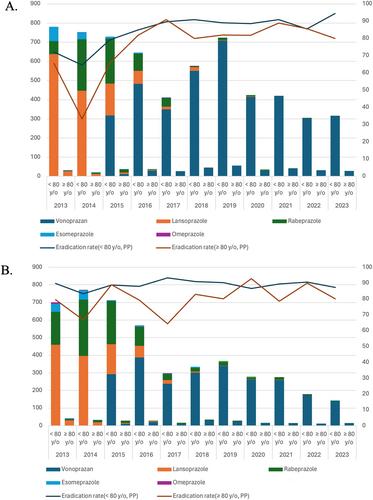Characteristics of Helicobacter pylori Eradication Therapy in Patients 80 Years or Older Living in a Metropolitan Area: A Multicenter Retrospective Study
Abstract
Background
The situation of Helicobacter pylori eradication therapy has been changing over time, owing to increases in antimicrobial-resistant strains, lifestyle improvements, and changes in indications for eradication. In Japan, eradication therapy is now available to all H. pylori-positive patients under the medical insurance system, and the potassium-competitive acid blocker vonoprazan has been used for eradication from 2015. Recently, with the aging of society, opportunities to provide eradication to elderly patients are increasing, but the current status and effectiveness of eradication in elderly patients remains unclear. Therefore, we aimed to investigate the trends of H. pylori eradication in a metropolitan area to determine the factors associated with successful H. pylori eradication in elderly patients older than 80 years.
Methods
Trends in the eradication rates of patients who received first- or second-line eradication at 20 hospitals in the Tokyo metropolitan area from 2013 to 2023 were investigated.
Results
The eradication rates in the per-protocol analysis were 82.3% (95% confidence interval [CI]: 81.2%–83.2%) for the first-line treatment (n = 6481), and 87.9% (86.9%–88.9%) for the second-line treatment (n = 4899). Multivariate analysis showed that independent factors for successful eradication in the first-line treatment were an age of older than 80 years (OR: 0.606; 95% CI: 0.448–0.822), peptic ulcers (vs. atrophic gastritis: 3.817; 3.286–4.433), and vonoprazan (vs. proton pump inhibiters (PPIs), 3.817; 3.286–4.433), and an age of older than 80 years (0.503; 0.362–0.699) and vonoprazan (1.386; 1.153–1.667) in the second-line treatment.
Conclusion
After 2015, the eradication rate of both first- and second-line therapies were maintained at a higher level than before 2015, owing to the use of vonoprazan. As the H. pylori eradication rate in patients older than 80 years was low, an effective strategy for these patients needs to be developed in the future.


 求助内容:
求助内容: 应助结果提醒方式:
应助结果提醒方式:


